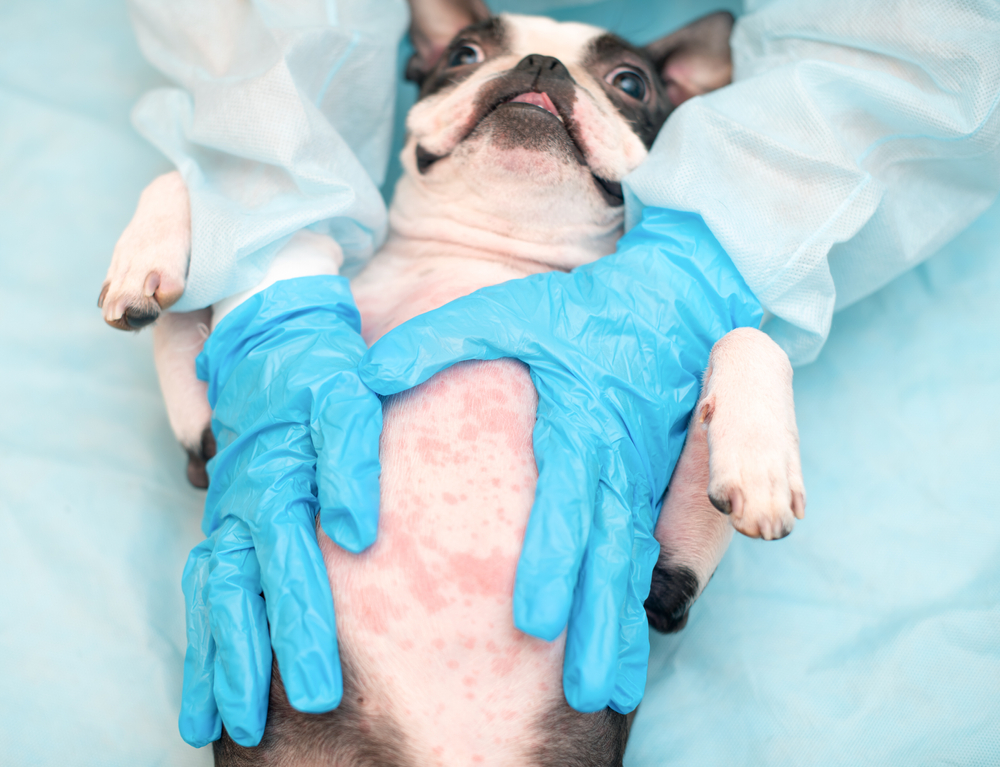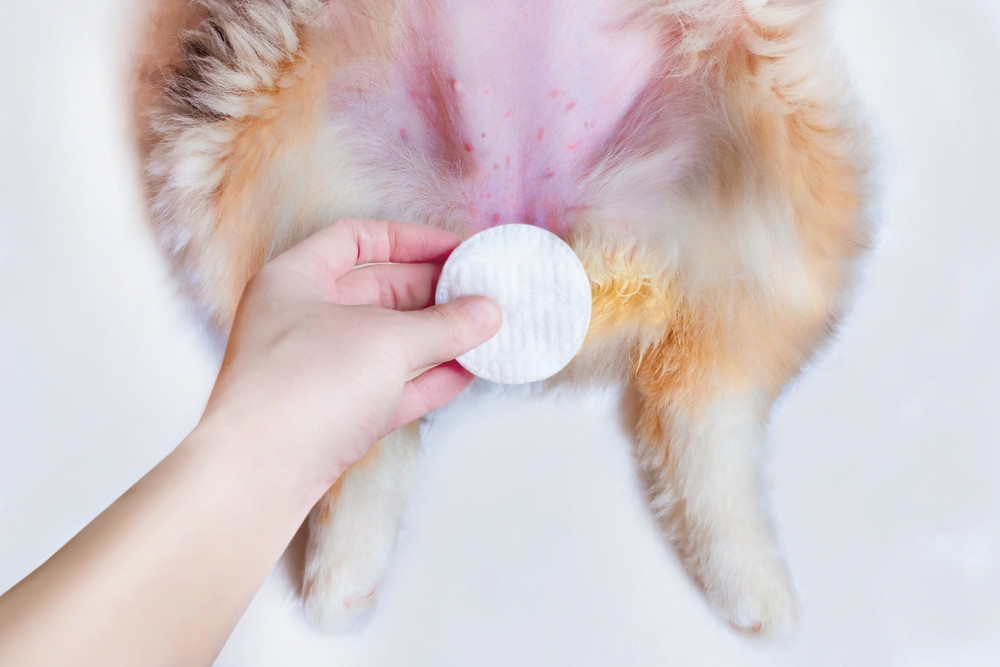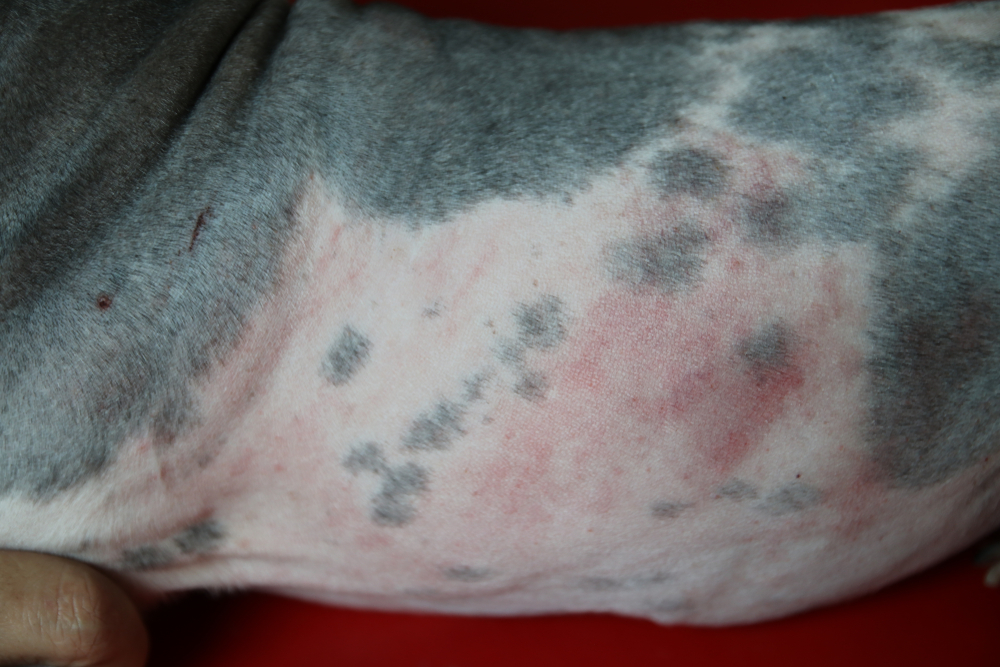Dog Belly Rash: 6 Causes and How to Help

Tummy rubs are one of the bright spots in a dog’s day. But if your dog has a rash on their tummy, those belly rubs will have to wait. Dog belly rash is usually minor but can be very uncomfortable. If you delay treatment, the rash can worsen and cause a possible skin infection.
Here’s what you need to know about dog belly rashes, from common causes to treatment and prevention.
Types of Dog Rashes on Belly
A rash is a temporary skin reaction that typically appears as some combination of red, scaly, bumpy, and itchy. Technically speaking, there are no “types” of rashes. But dog rashes have many causes (we’ll cover this in the next section) and varied appearances.
Although rashes can appear anywhere on a dog’s skin, the belly tends to be the most common location for dog rashes for several reasons. The belly is a large area of the body with minimal hair coverage. This puts the skin on the belly in contact with potential irritants, such as dust mites. In addition, the belly is an easy place for dogs to lick and scratch, causing more skin irritation.
Rashes on a dog’s stomach can appear as:
- Circular
- Bumpy
- Scabbed
- Raised
- Flaky
- Scaly
- Crusty
- Skin discoloration (pink, brown, red, black)
- Pustules, vesicles (fluid-filled sacs)
- Dry skin
Common Causes of Belly Rashes on Dogs

A rash is not a diagnosis in and of itself. Instead, a rash indicates an underlying condition that is causing the skin to react and become inflamed. Let’s go through some of the more common causes of belly rashes in dogs:
Infections
Bacteria and fungi are common causes of belly rashes on dogs. Bacterial skin infections, caused by bacteria such as Staphylococcus, are also known as pyoderma. Belly rashes in puppies are frequently due to pyoderma.
Common types of fungal skin infections in dogs include ringworm and yeast infections. Ringworm causes telltale circular rashes that appear red and scabby. A fungus called Malassezia pachydermatitis causes yeast infections, which are often smelly.
Allergies
Allergies are a very common culprit of rashes in dogs. Types of allergies include flea allergies, environmental allergies (atopic dermatitis), and food allergies. Contact allergies, which occur when the skin comes into direct contact with an irritant, can cause belly rashes in dogs. Each of these allergies can cause varying degrees of skin itchiness, leading to a rash.
Endocrine disorders
The endocrine system consists of hormones that regulate various bodily functions, such as growth and metabolism. Certain endocrine disorders, such as Cushing’s disease (overactive adrenal glands) and hypothyroidism (underactive thyroid glands), can negatively affect skin quality, leading to skin changes like rashes on a dog’s stomach.
Genetics
Some dog breeds are more likely to develop skin problems like belly rashes because of their genetics. For example, Golden Retrievers are genetically predisposed to environmental skin allergies, making them more susceptible to having belly rashes because of itchy skin.
Heat
Have you ever noticed that your skin gets red and itchy when it’s really hot outside? Dogs experience that, too! In hot weather, a dog’s skin can become irritated, leading to heat rash on a dog’s belly.
Pests and parasites
Fleas aren’t the only pests that irritate the skin enough to cause rashes. Ticks and mites are notorious for making a dog’s skin feel miserably itchy. The incessant itching and scratching can cause a rash on a dog’s tummy to develop.
Other Symptoms Associated with Dog Belly Rash

If your dog has a rash on their stomach, you’ll likely notice other symptoms beyond the rash itself. Other signs to watch for include:
- Hair loss
- Excessive licking and scratching where the skin is irritated
- Painful, sensitive skin
- Hives
- Dandruff
- Hot spots
- Foul odor
- Pus
Dog Belly Rash Treatment
Although belly rashes on dogs can often heal on their own, medical treatment is necessary to ensure adequate treatment and effective management of the underlying cause.
Because belly rashes are so uncomfortable, the sooner you can treat the rash, the better. However, don’t rush to your medicine cabinet to find an over-the-counter remedy. You should not use remedies designed for humans on your dog.
If your dog has a rash, take them to your veterinarian for diagnosis and treatment. Your vet will closely examine your dog’s rash and get a detailed history from you about the problem. Here are some questions your vet will likely ask you:
- When did you first notice the rash?
- What other symptoms does your dog have?
- Does your dog have allergies?
- Does your dog have an endocrine disorder?
- Is your dog receiving year-round flea and tick prevention?
Your vet will also perform some basic diagnostic testing to determine the cause of the rash. Testing may include skin scrapings to look for evidence of infection or parasites, blood work, or allergy testing. Your dog may also need a skin biopsy.
After your vet has identified the cause, they will recommend a treatment plan according to the underlying cause. For example, antibiotics will treat a bacterial skin infection, while an antifungal medication will treat a fungal skin infection. Other dog belly rash treatments may include:
- Medicated shampoos
- Flea and tick prevention
- Anti-inflammatory medication
- Anti-itch medication
- Treatment for endocrine disorder
- Oatmeal baths
Many treatments for dog belly rashes are topical and applied directly to the rash. However, if an endocrine disorder like Cushing’s is causing the rash, your dog would likely take oral medication to manage that disorder.
If your dog has a bacterial skin infection, complete the entire treatment course according to your vet’s instructions, even if the rash improves quickly. Doing so will prevent the development of treatment-resistant bacteria.
One more important note: Ringworm is contagious! If your dog has ringworm, your vet may advise you to wear gloves when applying the medicated ointment so that you don’t touch the rash directly.
How to Prevent Belly Rashes on Dogs

Rashes may not be entirely preventable, but there are some strategies you can use to help minimize your dog’s chances of getting them.
Year-round flea and tick control with a veterinarian-prescribed medication is essential to avoiding rashes from these pesky parasites. Your vet can recommend a good flea and tick control product for your dog.
To prevent heat rash, keep your dog’s belly dry with a soft, dry towel, and keep your dog in cool areas when it’s hot outside. Also, try to walk your dog in the early mornings and late evenings to avoid being out during the hottest part of the day.
Minimizing your dog’s exposure to skin irritants can be easier said than done, depending on your home environment, but doing so can help stave off skin rashes.
Managing allergies and endocrine diseases can help prevent the skin irritation and rashes associated with those health conditions. For example, you can manage food allergies with a special diet that does not contain the ingredients your dog is allergic to. If your dog has environmental allergies, try to minimize their exposure to irritants and manage flare-ups with medication.
With the right knowledge and care, you can tackle dog belly rashes — or even avoid them altogether — ensuring plenty of enjoyable belly rubs ahead!









